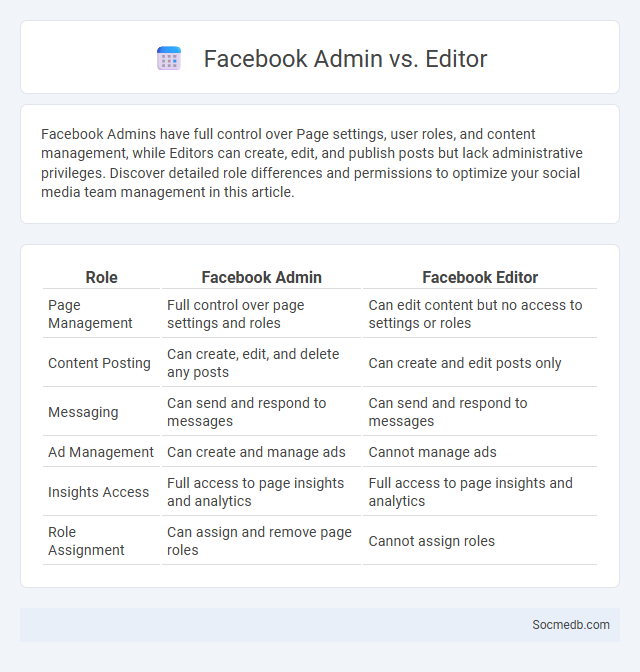
Photo illustration: Facebook Admin vs Editor
Facebook Admins have full control over Page settings, user roles, and content management, while Editors can create, edit, and publish posts but lack administrative privileges. Discover detailed role differences and permissions to optimize your social media team management in this article.
Table of Comparison
| Role | Facebook Admin | Facebook Editor |
|---|---|---|
| Page Management | Full control over page settings and roles | Can edit content but no access to settings or roles |
| Content Posting | Can create, edit, and delete any posts | Can create and edit posts only |
| Messaging | Can send and respond to messages | Can send and respond to messages |
| Ad Management | Can create and manage ads | Cannot manage ads |
| Insights Access | Full access to page insights and analytics | Full access to page insights and analytics |
| Role Assignment | Can assign and remove page roles | Cannot assign roles |
Introduction to Facebook Page Roles
Facebook Page Roles define specific access levels and permissions for managing your Page, allowing multiple users to collaborate efficiently. Roles such as Admin, Editor, Moderator, Advertiser, and Analyst control actions like posting content, responding to messages, creating ads, and viewing insights. Assigning the appropriate role ensures your team can contribute securely while maintaining control over your Page's management.
Overview of Facebook Admin Role
Managing a Facebook page requires overseeing content creation, user engagement, and community guidelines enforcement to maintain a consistent brand presence. You must monitor interactions, respond promptly to messages and comments, and use analytics tools to track page performance and audience growth. Effective Facebook admins leverage these capabilities to enhance visibility and foster a loyal online community.
Overview of Facebook Editor Role
Facebook Editors manage and curate content to enhance community engagement and brand presence on the platform. Your responsibilities include scheduling posts, moderating user interactions, and analyzing audience insights to optimize content strategy. Proficiency in Facebook's publishing tools and understanding of social media metrics are essential for success in this role.
Key Responsibilities of a Facebook Admin
A Facebook Admin is responsible for managing page content, including posting updates, responding to comments, and moderating user interactions to maintain a positive community environment. They analyze page insights and metrics to optimize engagement strategies and grow the audience effectively. Managing ad campaigns, setting user roles, and ensuring compliance with Facebook policies are also crucial tasks for maintaining page integrity and security.
Key Responsibilities of a Facebook Editor
A Facebook Editor manages content strategy by curating, creating, and publishing posts tailored to audience engagement metrics and platform algorithms. They analyze insights to optimize reach, maintain brand voice consistency, and respond promptly to user interactions, fostering community growth. Collaboration with marketing and design teams ensures alignment with campaign goals and timely content delivery.
Differences Between Admin and Editor on Facebook
Facebook admin roles have distinct permissions where an Admin has full access to manage page settings, assign roles, and moderate content, ensuring comprehensive control over the page. Editors can create and publish posts, respond to messages, and manage comments but lack the ability to assign roles or change page settings. Understanding these differences optimizes team collaboration and maintains page security.
Access and Permissions Comparison
Social media platforms vary significantly in access controls and permission settings, directly impacting user privacy and data security. Facebook offers granular permission options, allowing users to control who views posts and personal information, while Twitter provides more limited but straightforward privacy settings primarily focused on tweet visibility. Instagram combines visual content sharing with adjustable account privacy modes, enabling users to switch between public, private, and close friends-only access.
Best Practices for Assigning Page Roles
Assigning page roles on social media ensures efficient management and security of your brand presence by granting appropriate access levels to team members. Use clear role definitions such as Admin, Editor, Moderator, Advertiser, and Analyst to match responsibilities with permissions, minimizing risks of unauthorized actions. Regularly review and update roles to maintain control over your page and protect your social media assets.
Security Considerations for Page Roles
Managing social media page roles requires strict security considerations to prevent unauthorized access and potential data breaches. Assigning roles should follow the principle of least privilege, ensuring users only have necessary permissions tailored to their responsibilities. Regular audits of role assignments and strong authentication practices, such as two-factor authentication, enhance protection against cyber threats targeting social media accounts.
Choosing the Right Role for Your Team
Selecting the right social media roles within your team enhances content creation and audience engagement by aligning skills with platform demands. Assign dedicated specialists for analytics, content strategy, and community management to ensure data-driven decisions and consistent brand messaging. Clear role definition optimizes workflow efficiency and drives measurable growth across channels like Instagram, LinkedIn, and TikTok.
 socmedb.com
socmedb.com